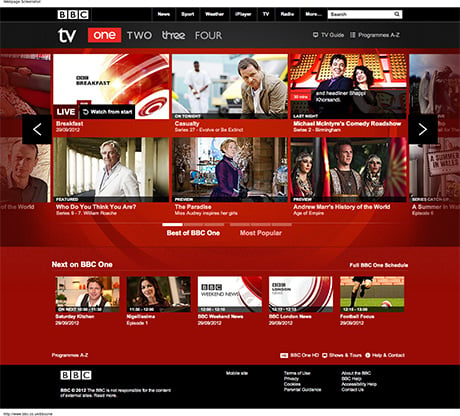The business of design: Yasser Rashid, BBC
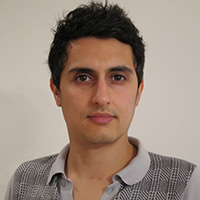
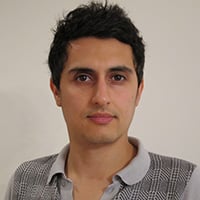 In the second of the our business of design series we talk to Yasser Rashid, Head of User Experience and Design for TV & iPlayer, Radio & Music at the BBC.
In the second of the our business of design series we talk to Yasser Rashid, Head of User Experience and Design for TV & iPlayer, Radio & Music at the BBC.
Initiatives such as iPlayer and the Global Experience Language (GEL) mean the BBC is often held up (certainly by me) as an icon for how traditional media organisations can and should operate in a digital world.
In this interview Yasser talks about a diverse range of topics including the challenges he faces, his biggest successes, where new ideas come from, the importance of analytics, designers working with Agile and 101 other things besides. Three quotes in particular stand out:
- "It’s important to have an objective way to track what you are doing and it helps to drive decision making in the organisation."
- "The design is one part of the story, the other part is how it influenced presenters and production teams to think about how their content is published online and how they engage with their audience."
- "Some people argue that by designing from the data upwards helps to make the technical development easier, however doing it the other way around, may be more challenging and take longer, but it opens up the opportunity for innovation."
Can you tell me a bit about your role?
I lead the User Experience and Design (UX&D) team for BBC TV and iPlayer, Radio and Music.
In practical terms it means my team is responsible for the user experience and design of iPlayer which is one of the key products for the BBC. We are responsible for how it evolves, improving the interface and thinking about its future across all platforms on TV, mobile, tablet and web.
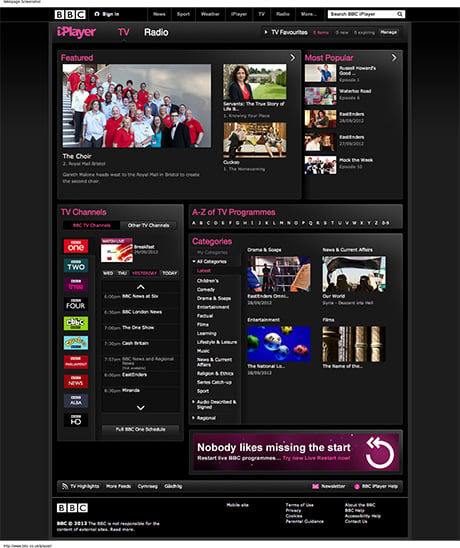
We are also responsible for the TV Channel websites such as BBC One and TV shows that have a digital presence, such as The Voice and Strictly Come Dancing.
The other half of the portfolio is Radio and Music. This includes iPlayer Radio, the brand that brings together all of BBC Radio websites such as Radio 1 and Radio 4 and anything music related that the BBC covers, the BBC Music Showcase is an example.
Sounds like an absolutely fantastic role. Do you skip and whistle to work every day?
It’s an exciting role. I get to work with a lot of different people in the organisation such as editorial, technology, marketing and product management. Each different discipline works together to achieve our ambitions for products and services within the portfolio.
My role is end to end. I’m involved in the strategic, concepting and briefing of things right at the beginning through to implementation.
Can you tell me a bit about your team and the teams you work with?
My team is about 15 people made up of creative directors, senior user experience designers, experience designers and user experience architects. Across all our projects we collaborate with a variety of different disciplines. In my role for example I’m part of the core strategic team that drives projects. I work with an editorial executive, a product management executive and a technical lead on a regular basis to discuss the portfolio. We also involve people from marketing and audience insights to ensure that we are promoting new launches, reaching new audiences and getting insights into how our products are performing.
Where do the ideas for new enhancements come from?
It really varies. In the case of Radio 1, there was an opportunity to rethink and rework the entire digital experience. It was an opportunity we identified in the UX&D team and we created ideas that really engaged the station. Other times there could be an editorial need, such as a new prime time TV program that will drive the early stages of concept development. From product management it could be statistics identifying an area of the portfolio that is underperforming so a rethink of the UX may be necessary. There are also audience needs, trends and behaviours that can influence our work to. Generally inspiration comes from a variety of places.
So what types of analytics and metrics are used?
We are talking about a range of stats. In terms of iPlayer it ranges from how many people are watching content and what areas of the website are they clicking on - this informs our view of which areas of the user experience are working well or not.
On top of that we run a survey across all our websites. This helps us to understand whether people value the product and it gives us a benchmark on which to look at our performance over time. In terms of the UX&D team, we are measured on aspects of that survey, such as ease of use and appearance and we take those measurements very seriously.
It’s important to have an objective way to track what you are doing and it helps to drive decision making in the organisation.
Many organisations are awash with data, but they lack insights to help them understand the data, does that resonate with you?
We do have a lot of data but we have a team of people who are real experts in what they do and produce regular easy to digest reports on how our products are performing.
What are the biggest successes you’ve enjoyed?
For me the transformation of Radio 1 was a big one. It was led by the design team and we worked collaboratively with our editorial colleagues. We had a vision of how we wanted it to be implemented and it was implemented in that way. It really transformed how the station saw itself online. What you see online is Radio 1 in real-time. The design is one part of the story, the other part is how it influenced presenters and production teams to think about how their content is published online and how they engage with their audience. The project got the production teams rethinking their shows in a digital context. It was quite powerful.
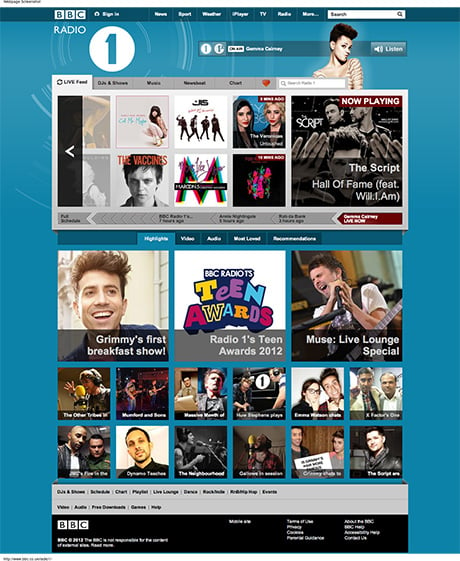
The other project I’ll mention is the recent refresh of the TV channels BBC 1, 2, 3 and 4. It was the first fully responsive design website that the BBC has launched and it was a great learning experience for everyone involved. I think it has created a fantastic foundation for the future.
Can you tell me more about the challenges you face establishing design-led approaches on projects?
The challenge with design led projects is when they occur in isolation from the technical team.
There are times when the UX&D team has to look at the big picture and design a product holistically. The final outcome is a vision piece that articulates what we want the product to be when it launches. The challenge is how we achieve that vision. Without some technical engagement it can be difficult to assess how long or how feasible that vision is. It can be problematic if your vision has buy in from senior stakeholders but when you want to build it, it's not achievable which means having to change direction.
Some people argue that by designing from the data upwards helps to make the technical development easier, however doing it the other way around, may be more challenging and take longer, but it opens up the opportunity for innovation. There is no right and wrong it’s just that there are different schools of thought for how to approach certain projects.
Do you get involved up to and beyond the launch of a project?
Yes. I basically have on-going involvement. Our product development cycle never ends. The things I am looking after are being developed for as long as they exist. For example, the iPhone mobile app has been in the app store for quite a while, but we recently launched download functionality. My team had to pick that up and do the design work for it. We are continually improving things and gathering feedback from the audience and thinking about what happens next.
From what you’ve said, I’m guessing you have an Agile development methodology? If so, how does that impact your work?
We do have an Agile methodology. We generally work to sprints and sprint cycles. The teams run 3 week sprints. We have a hybrid model where we do some up-front thinking to work out what the experience of the product should be. Then we work with the technical and project management teams to break down the product into features or components. We work out our sprints based on that.
So we have a vision piece and then Agile. How long we have for the vision varies. Some projects have a definitive deadline and so we don’t really have much time up front for concept work. Other projects can have a bit more opportunity for work up front - maybe three or four weeks. During that period we will review and get buy-in from stakeholders.
Generally we have to get buy-in from a variety of stakeholders early on. I have one project that is launching in a few weeks that was done by stealth. Fortunately that was successful, people bought into it when they saw it.
Why were you working in stealth mode?
I wanted to prototype it. I created something that worked and that people could use. It was quite a simple proposition, but people have really enjoyed it and liked it straight away. There wasn’t any argument. I can’t talk about any details because it hasn’t actually launched.
The prototype was fully interactive. Not every designer on our team can code and work up prototypes, but generally I think it is an important skill to have. You can only do so much with mock-ups. Particularly when you are designing native apps for iOS and Android. We will do a bunch of sketches and start talking about how things will move. The only way you can crystalise that in people’s minds is to have a prototype that actually does something and illustrates the animations and transitions.
My expectation is that people in the UX&D team have a basic knowledge of HTML, CSS and Javascript, so that they can tweak code and build simple prototypes. But when we go all out and do native app prototyping or dynamic websites we will partner with a technical team either in-house or an external partner.
The power of making things tangible through prototypes is amazing isn’t it.
Yeah. We create prototypes in the early stages of a project as its an important part of our user testing process. We also try to prototype around our sprint cycles. There may be a team dedicated to designing features and another team that is looking ahead all the time and thinking about stuff that isn’t in production but that we should be doing later on. They build prototypes to show what we’re aiming for in the long term.
You mentioned about partnering with people outside the company, is that something you do a lot and are there particular types of skills you look outside for?
We do it a lot. We have a remit to commission a certain amount of work. I have a budget where my team are focussed on the strategic work and a little bit of BAU, but when it comes to prototypes we usually have to partner with 3rd party technical teams. We work with companies who have the capacity to build stuff quickly.
We also engage external teams on certain projects where we need a fresh perspective and . we partner with agencies that specialise in user testing when we need to gain audience insights during product development.
There is a trend that organisations are thinking and designing for cross-channel experiences, but I am guessing in your world you’re dealing with concurrent multi-channel experiences, i.e. people using one device while watching another. Is that right?
It is a given now that when we design something that people will ask does it work on a mobile, a tablet, a tv, a laptop, etc it is natural thing. That interaction between channels we are still working out.
Is there an appetite for it?
Companies like Zeebox are helping to lead the way, but I think in this case we are experimenting – we don’t see it as a mass market proposition at this stage. It will be interesting to see who out there is going to create a compelling companion experience that will take off.
Social media is integral to the editorial output. Some TV shows flash up a hash tag and there will be a Facebook and Twitter presence. The Olympics coverage from the BBC was a good example of how social media was used to share content, reporters tweeting with real time updates and curating content from social media as events were happening.
Are there any particular books, online materials or advice you’d give to designers working in a business environment?
Working in a large organisation there are many projects happening at any one time and so there is an opportunity to be proactive, learn and work on stuff that really interests you. It’s also a great environment to work collaboratively with other disciplines and learn from them.
If you spot an opportunity and want to make things happen then you have to be able to tell a good story to get people in the organisation excited in your idea and invest in it. You also need to be brave and challenge the status quo with your vision and passion for what you want to create and achieve. I’m lucky, I work on things I really care about and that drives my ambition to see things through.
Being up to date on the latest trends and understanding how the audience of your organisation are using your products and services is key to being at the cutting edge and creating good work that people will use.
Having a sense of what is happening out in the wider industry is also important which is why I try and attend various events. I regularly go to dConstruct every year in Brighton. It's a great conference and I try and take the entire team. Its a good forum to get inspiration and meet people.
This interview was conducted by Iain Barker. If you would be interested to be interviewed as part of the business of design series, please contact iain@meldstudios.com.au.
You can read more from Yasser at his blog, www.mutedialogue.com.

